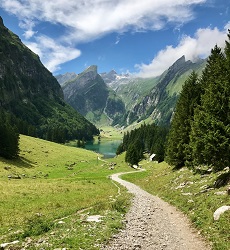- Tags:
- Hebrews
- Jesus
- John
- New Testament
- Rob Eyman
Every long road trip includes some “must see” attractions. Like the En Gedi oasis in the Judean wilderness, these are the places that stand out from the rest of the scenery and give us a refreshingly different perspective on the landscape. The New Testament book of Hebrews is just such a place.

We don’t know who wrote this book. It is so different from our familiar Pauline landscape that it likely was not Paul. Chapter two lets us know that the author was probably a second generation Christian who learned the faith from the Apostles (instead of from Jesus). We know that he understood Old Testament history and law well, was closely connected with his audience (he knew the details of their experience), was educated in the Greek language (we find 151 Greek words in Hebrews that appear nowhere else in the New Testament) and was Timothy’s friend (13:23). Yet, even with all these clues, the author remains a mystery.
Tertullian (A.D. 155-220) thought it might be Barnabas, since he was a Levite (which gives him an edge on knowing the Old Testament) and an exhorter (which matches the book’s purpose, 13:22). Martin Luther thought Apollos—a learned man from Alexandria who had a thorough knowledge of the Scripture (Acts 18:24)—might be the author. Apollos would have known the Old Testament and likely would have had the Greek skills as well. In the last century the candidate list has expanded to include Priscilla, Silas and Epaphras.
In the end, I believe we will never know the author’s identity on this side of heaven. Even so, we can certainly affirm that he (or she?) was well versed on the subject matter and fully convinced that God had made Himself known to us in His Son, Jesus Christ. Knowing that the book was written before 70 A.D. only adds to the evidence that worshipping Jesus as the incarnate God was an original and central part of early Christian doctrine and was not tacked on later in an effort to legitimize the faith or gain power in the political realm.
I hope you will take some time to ponder the beauty and power of this scenic letter. As I have shared in the past, I encourage you to take 9 minutes and watch the Bible Project overview video (on Right Now Media or YouTube). Like reviewing the map before you drive through the area, doing so will let you become familiar with the terrain and help you not miss some of the important vistas.
As you travel, make sure you take a moment to consider what is found in 2:5-18 (especially verse 9). Jesus had to become like us so that He could “taste death for everyone” and, in so doing, destroy the one who holds the power of death and free us from the fear of death. To say that Jesus “tasted death” is to say that He experienced the full force of its horror—the full force of separation from God—so that we won’t have to!
Alongside this, think also about Jesus’ words in John 11:25. “I am the resurrection and the life. The one who believes in me will live, even though they die; and whoever lives by believing in me will never die.” Read that again and imagine someone actually saying these words to you. How do you respond? Now realize that the One speaking these words is Jesus, God incarnate, the One who rose from the dead. Think of this. Your death will not be death because, in Jesus, you are swallowed up by life (2 Corinthians 5:4)! How might this one truth alone impact your approach to the circumstances you experience today?
Hebrews 2 is only one of the amazing views along the Hebrew’s road. There are many more to see for those who are willing to pause long enough to appreciate the view. I’d love to hear which vistas stood out to you as you travel this amazing path so feel free to share your story with me.
Every long road trip includes some must see attractions. I pray that the Lord may help each of us take in what Hebrews has to offer.

Rob






